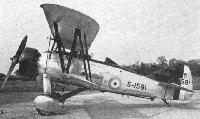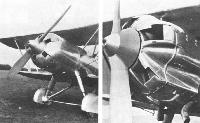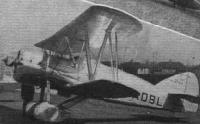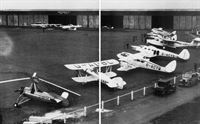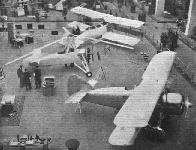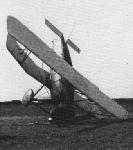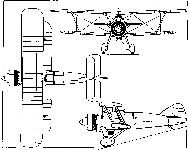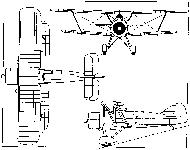
Варианты
- Armstrong Whitworth - Scimitar / A.W.16 / A.W.35 - 1931 - Великобритания
- Avro - Type 636/667 - 1935 - Великобритания
Jane's Encyclopedia of Aviation
Armstrong Whitworth A.W.35 Scimitar (UK)
Single-seat biplane fighter, the prototype of which was the converted A.W.16 and first flew on 25 June 1934. Four production aircraft were built for Norway, powered by the 540 kW (725 hp) Armstrong Siddeley Panther XI radial engine and armed with two forward-firing Vickers machine-guns and underwing racks for light fragmentation bombs.
Описание:
- Jane's Encyclopedia of Aviation
- Flight, June 1931
SPECIAL TYPES AT THE DISPLAY - Flight, October 1931
Two New Military Aircraft - Flight, November 1932
British Aircraft - Flight, November 1934
MODERN BRITISH AIRCRAFT REVIEWED
Фотографии
-
Aeroplane Monthly 1982-04 / R.Williams - Armstrong Whitworth's unnamed fighter
Регистрационный номер: S1591 [5] The prototype AW 16, S1591, was first flown on December 30, 1930 by A. Campbell-Orde.
-
Aeroplane Monthly 1982-04 / R.Williams - Armstrong Whitworth's unnamed fighter
The second prototype AW 16, A-2, first flew on October 6, 1931.
-
Flight 1931-10 / Flight
THE SINGLE SEATER: The Armstrong-Whitworth A.W.XVI (Armstrong-Siddeley Jaguar Major). This three-quarter rear view shows off the clean lines of this fast machine to good advantage.
-
Flight 1931-10 / Flight
THE A.W.XVI: The well faired undercarriage and the efficient Townend ring engine cowling ate particularly noticeable in this view.
-
Flight 1936-04 / Flight
The A.W. XVI (Panther) of a few years ago; it had an inner flange cowl in addition to its Townend ring. This arrangement is not now standard on the two-row Siddeleys.
-
Flight 1931-10 / Flight
A CLEAN UNDERCARRIAGE: Both the Armstrong-Whitworth Atlas II and A.W.XVI have well faired undercarriages with "spats" over the wheels. Our sketch shows what an admirable result has been achieved.
-
Flight 1931-10 / Flight
The second AW 16, A-2, flying at Whitley Abbey in October 1931
In spite of its high powered radial air-cooled engine the A.W.XVI looks very clean even for a single-seater fighter. The height of the pilot's head shows that he had the seat in its top position when our photograph was taken. -
Flight 1932-11 / Flight
Armstrong-Whitworth (Type A.W.XVI)
-
Aeroplane Monthly 1982-04 / R.Williams - Armstrong Whitworth's unnamed fighter
Регистрационный номер: S1591 [5] AW 16 S1591 on HMS Courageous during September 1933 when Fg Off Adye carried out trials on behalf of 800 Sqn FAA.
-
Aeroplane Monthly 1982-04 / R.Williams - Armstrong Whitworth's unnamed fighter
Регистрационный номер: S1591 [5] The prototype AW 16, S1591, before modifications to improve the aircraft’s spinning characteristics took place.
-
Flight 1931-06 / Flight
Регистрационный номер: S1591 [5] -
Air Enthusiast 1972-03 / Fighter A to Z (10)
Регистрационный номер: S1591 [5] The first A.W.16 (S1591), the shipboard prototype, in its final form.
-
Aeroplane Monthly 1982-04 / R.Williams - Armstrong Whitworth's unnamed fighter
A production AW 16 in pristine condition before delivery. The AW 16 had a wing span of 33ft, was 25ft 6in long and had a wing area of 261-35 sq ft.
-
Aeroplane Monthly 1982-04 / R.Williams - Armstrong Whitworth's unnamed fighter
Two AW 16s at Hunjao airfield, Shanghai in May 1934 before delivery to Kaifeng.
-
Aeroplane Monthly 1982-04 / R.Williams - Armstrong Whitworth's unnamed fighter
AW 16s of the Kwangsi Air Force.
-
Flight 1934-01 / Flight
FIGHTING EQUIPMENT: Three A.W.XVI's ("Panther IIa") at Shanghai. The ruins in the background, before a Japanese bombardment during the first Sino-Japanese conflict, were hangars.
-
Aeroplane Monthly 1982-04 / R.Williams - Armstrong Whitworth's unnamed fighter
Регистрационный номер: G-ABRH, G-ABRJ Two mystery photographs of an unidentified AW 16 photographed with different temporary civil marks. Why this aircraft was so painted is not known.
-
Aeroplane Monthly 1982-04 / R.Williams - Armstrong Whitworth's unnamed fighter
Регистрационный номер: G-ABKF [3] A rare photograph of AW 16 G-ABKF, seen at Germiston Aerodrome, Rand on January 8, 1933.
-
Aeroplane Monthly 1986-11 / R.Williams - Scimitar saga (1)
Регистрационный номер: G-ACCD [9] The AW 16 G-ACCD at the SBAC Exhibition in June 1933. A year later the aircraft become the prototype AW 35 Scimitar.
-
Aeroplane Monthly 1982-04 / R.Williams - Armstrong Whitworth's unnamed fighter
Регистрационный номер: G-ABKF [3] The AW 16 G-ABKF fitted with the 15 cylinder Armstrong Siddeley Hyena and tight fitting cowling. The Hyena consisted of three five-cylinder radials mounted in line on a common crankcase.
-
Air Enthusiast 1973-07 / In print
Регистрационный номер: G-ABKF [3] Two of the rare illustrations from "Armstrong Whitworth Aircraft Since 1913" reviewed alongside, showing the A.W.XVI G-ABKF when fitted experimentally with the A.S.Hyena engine and various types of cowling designed to overcome cooling problems.
-
Aeroplane Monthly 1986-11 / R.Williams - Scimitar saga (1)
Регистрационный номер: G-ACCD [9] The Scimitar was the last of a line of Armstrong Whitworth biplane fighters.
-
Aeroplane Monthly 1986-11 / R.Williams - Scimitar saga (1)
Регистрационный номер: G-ACCD [9] -
Aeroplane Monthly 1986-11 / R.Williams - Scimitar saga (1)
Регистрационный номер: G-ACCD [9] ARMSTRONG WHITWORTH SCIMITAR. Built originally as a private venture, the A.W.35 Scimitar was supplied in the mid-thirties to the Royal Norwegian Air Force. A very clean aircraft, the Scimitar had a top speed of 213 m.p.h. at 14,000 ft. when powered by a 640-h.p. Armstrong Siddeley Panther VII radial. As an alternative, the Tiger of 725 h.p. could be mounted. Span was 33 ft., length 25 ft. and all-up weight 4, 100 lb. Armament consisted of two Vickers guns firing through the propeller disc.
-
Aeroplane Monthly 1986-12 / R.Williams - Scimitar saga (2)
Регистрационный номер: G-ACCD [9] The prototype Scimitar photographed at Torslanda in Sweden, probably in September 1934. An engineer is winding up the Panther VII engine.
-
Aeroplane Monthly 1986-11 / R.Williams - Scimitar saga (1)
Регистрационный номер: G-ACCD [9] Showing traces of its Siskin ancestry, the Scimitar had a stepped fuselage which provided for a raised cockpit to afford the pilot excellent forward vision.
-
Jane's All the World Aircraft 1980 / Encyclopedia of Aviation - Aircraft A-Z - v2
Регистрационный номер: G-ACCD [9] Armstrong Whitworth Scimitar.
-
Aeroplane Monthly 1986-11 / R.Williams - Scimitar saga (1)
Регистрационный номер: G-ACCD [9] Scimitar G-ACCD at the third SBAC Show, held at Hendon on July 2, 1934, where the new fighter was impressively demonstrated by Charles Turner Hughes in company with the A.W.19, flown by Campbell-Orde.
-
Flight 1934-07 / Flight
Регистрационный номер: G-ACCD [9] THE "SCIMITAR": A single-seater fighter of the Armstrong-Whitworth range. The engine is a 640-h.p. Siddeley "Panther."
-
Aeroplane Monthly 1986-12 / R.Williams - Scimitar saga (2)
Регистрационный номер: G-ADBL [4] The second Armstrong Whitworth Scimitar demonstrator, G-ADBL, was also an A.W.XVI conversion. It survived until scrapped in 1958.
-
Flight 1935-12 / Flight
Регистрационный номер: G-ADBL [4] Armstrong Whitworth Scimitar (600 h.p. Panther).
-
Aeroplane Monthly 1985-06 / N.Ewart - When flying was still an adventure (3)
Регистрационный номер: G-ADBL [4] Visiting aircraft at Croydon in the late Thirties.
Другие самолёты на фотографии: Cierva/Avro C.30A / Rota - Великобритания - 1932De Havilland Dragon Rapide / Dominie / D.H.89 - Великобритания - 1934Saunders-Roe Cloud / A.19 - Великобритания - 1930Spartan Cruiser - Великобритания - 1932
-
Flight 1936-04 / Flight Advertisements
Регистрационный номер: G-ADBL [4] -
Aeroplane Monthly 1986-12 / R.Williams - Scimitar saga (2)
Norwegian Army Air Force Scimitar photographed at Whitley in 1935. Norwegian Scimitars were powered by the 624 h.p. Panther IXA engine.
-
Air Enthusiast 1972-03 / Fighter A to Z (10)
The Panter XIA-powered A.W.35 Scimitar.
-
Flight 1935-11 / Flight
One of Recent British Fighters: Armstrong Whitworth Scimitar
-
Aeroplane Monthly 1986-12 / R.Williams - Scimitar saga (2)
No 405 with inspection panels removed. In accordance with the usual Norwegian Army Air Force practice of naming their aircraft after birds, is was planned to name the Norwegian-built Scimitars “Falk”.
-
Aeroplane Monthly 1986-12 / R.Williams - Scimitar saga (2)
Scimitar No 411 of the Norwegian Army Air Force.
-
Flight 1935-10 / Flight
SHINING BLADES FOR NORWAY: Three of a batch of four Panther-engined A.W. Scimitar fighters which is soon to be delivered to Norway, The Norwegian Government has secured the licence to build further machines of this type.
-
Aeroplane Monthly 1986-12 / R.Williams - Scimitar saga (2)
Three of the four Norwegian Scimitars lined up at Whitley before delivery to Norway early in 1936. Planned licence production of the Scimitar in Norway did not materialise.
-
Aeroplane Monthly 1986-12 / R.Williams - Scimitar saga (2)
A Norwegian Army Air Force Scimitar fitted with skis. The aircraft’s structure was not strong enough for this type of operation and this, coupled with the Scimitar’s below par performance, influenced Norway’s decision not to put the type into production.
-
Flight 1934-11 / Flight
This combined Armstrong-Whitworth and A. V. Roe stand is one of the most attractive in the Show. All the three machines are painted white, with their exposed metal surfaces plated.
Другие самолёты на фотографии: Avro Tutor/Sea Tutor/Prefect / Type 621/646/626 - Великобритания - 1929Cierva/Avro C.30A / Rota - Великобритания - 1932
-
Flight 1934-08 / Flight
ON THE S.B.A.C. STAND: Bristol and Rolls-Royce engines in the foreground, with the de Havilland "Moth Major" behind them. Farther back can be seen the Armstrong-Whitworth "Scimitar," and on the right the Avro built Autogiro.
Другие самолёты на фотографии: Cierva/Avro C.30A / Rota - Великобритания - 1932De Havilland Moth Major / D.H.60GIII - Великобритания - 1932
-
Aeroplane Monthly 1986-11 / R.Williams - Scimitar saga (1)
All the Scimitar's cockpit instruments were readily visible to the pilot. The flying instruments were grouped on the left of the panel, and those for the engine were ranged on the right. The pilot's seat was adjustable for height.
-
Air Enthusiast 1972-06 / Talkback
A.W.16 that came to grief during their service with the Kwangshi Air Force in China. At least six A.W.16s were shipped to China in the period 1932 to 1935.
-
Flight 1935-01 / Flight Advertisements
The A.W. Scimitar all metal single seater fighter
-
Flight 1935-05 / Flight Advertisements
A Great Combination The A.W. Scimitar all metal single seater fighter with SIDDELEY PANTHER Engine
-
Flight 1931-10 / Flight
The new brackets for holding on the Townend ring are shown on the right. The steel links A are flexible while the bushes B are of rubber and the pins C are a loose fit. The resulting flexibility has obviated cracking of the ring.
-
Flight 1931-10 / Flight
The neat interplane strut end fairings and their method of assembly are shown.
-
Flight 1931-10 / Flight
FOR THE PILOT'S COMFORT: The Armstrong-Whitworth A.W.XVI has the above method of adjusting the pilot's rudder bar.
-
Flight 1931-10 / Flight
DETAILS THAT COUNT: Above, our artist shows how the tail lamp has been fitted snugly into the rudder, while below he depicts the method by which the tail plane has been faired to the fuselage of both the Atlas II and A.W.XVI.
Другие самолёты на фотографии: Armstrong Whitworth Atlas / Ajax - Великобритания - 1925
-
Flight 1931-10 / Flight
OUT OF THE SLIPSTREAM: The electrical generators on these new Armstrong-Whitworth aircraft have been placed inside the fuselage fairing. Our sketch, here shows the generator for lighting and heating on the right-hand side of the machines. The view on the left illustrates the clean result when the fairing panel is over the generator and shows the two ventilators for keeping it cool.
-
Air Enthusiast 1972-03 / Fighter A to Z (10)
The A.W.16 in developed form.
-
Air Enthusiast 1972-03 / Fighter A to Z (10)
The Panter XIA-powered A.W.35 Scimitar.
-
Flight 1931-10 / Flight
Armstrong-Whitworth A.W.XVI Armstrong Siddeley "Panther" Mk.IV Engine
- Фотографии











